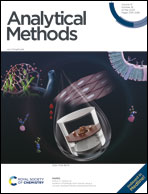In situ formation of chloroform for dispersive liquid–liquid microextraction of some aromatic amines from aqueous samples optimized by central composite design prior to GC-MS analysis†
Abstract
In the current research, an in situ solvent formation-liquid phase microextraction method based on chloroform has been introduced as an efficient sample preparation procedure and applied for the extraction and preconcentration of some aromatic amines from wastewaters. In this method, chloral hydrate (2,2,2-trichloroethane-1,1-diol) was added to an alkaline solution of the samples in order to form chloroform as an extraction solvent in the sample solution. Thus, the selected analytes were transferred from the aqueous solution into the tiny droplets of the produced chloroform. Following this, the extracted and enriched analytes were quantified using a gas chromatograph-mass spectrometer. Experimental conditions of the proposed method including the chloral hydrate amount, salt effect, extraction time, and sodium hydroxide concentration were studied and optimized by a central composite design approach. By the offered method, high enrichment factors (292–324) with satisfactory extraction recoveries (82–91%), low limits of detection (0.26–0.39 ng mL−1), and proper repeatability (relative standard deviations ≤6.3% for intra- and inter-day precisions) were achieved under optimum conditions. Eventually, the suggested method was assessed through the quantification of aromatic amines in aqueous samples.



 Please wait while we load your content...
Please wait while we load your content...